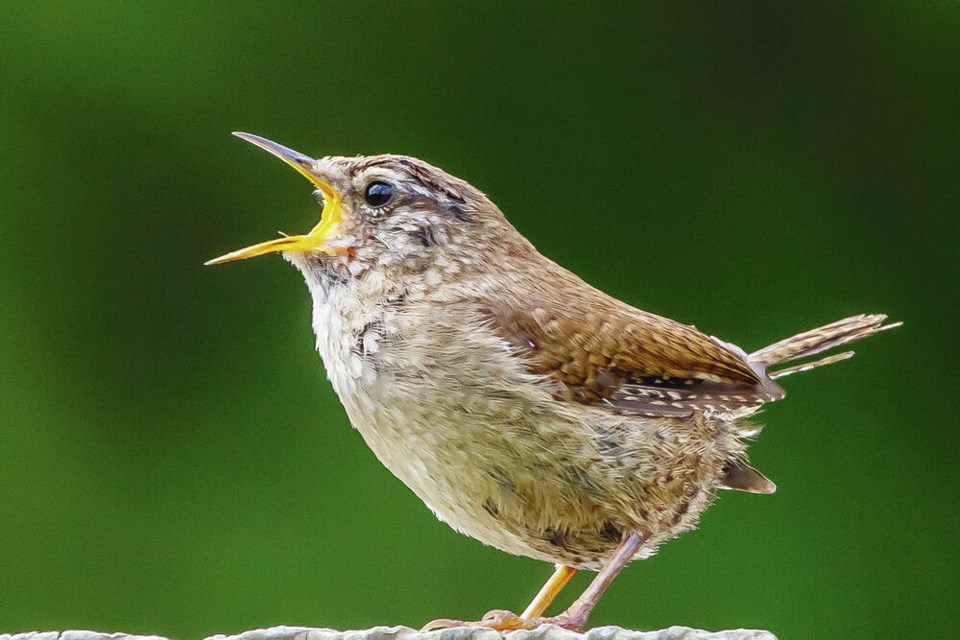As spring springs, the mornings become light earlier, and old friends, winged, leafy and otherwise, return for another growing season — the season’s morning alarm clock is gearing up.
But research out of the University of Lethbridge suggests the early-morning phenomenon we call the “dawn chorus,” when songbirds sing intensely during the early morning before tapering off as the morning progresses, may not be the main event after all.
It may simply be the equivalent of the mashup of sound that comes from the stage before a Victoria Symphony performance as the audience is taking its seat, or the soundstage checks and band tuning up while Taylor Swift runs through her voice exercises backstage pre-show.
The early — and sometimes, it seems, way too early — daily chorus may be songbirds’ vocal warmup period as they prepare for maximum song performance during the day.
According to the Lethbridge researchers, birds warm up their voices just like human singers would before a performance.
There are many hypotheses as to why the dawn chorus happens, says researcher Juleyska Vazquez Cardona, including the voice warm-up one.
Using detailed metrics, the researchers identified vocal-performance changes in Adelaide’s warblers as the birds progressed through their dawn voice exercises in the dry forests of southwestern Puerto Rico.
The researchers recorded the birds from before sunrise — before the warblers start singing — and continuously throughout the dawn chorus, capturing the 20- to 25-minute period when the birds sing intensely. Recording then continued for about another hour.
Using more detailed metrics than had been used in previous studies, the scientists then analyzed the recordings, identifying performance changes in the warblers as they progressed through their warmup. These measures include recovery time, voiced frequency modulation and unvoiced frequency modulation.
The measures quantify how fast an individual bird can sing, how complex its song pattern is, and the gaps between the notes.
Most of us humans can’t hear the finer details of birdsong — a complicated trill of eight notes back and forth to a warbler’s ear may sound like a single longer-held note to ours. For us to truly appreciate the intricacies of a bird’s performance, recordings of their song have to be slowed down before they can be picked apart.
“We found that singing at a high rate through the dawn chorus increased the birds’ performance in both recovery time and unvoiced frequency modulation,” says Vazquez Cardona, who grew up in Puerto Rico before moving to Alberta to study.
The birds’ performances were slowest first thing in the morning, increased rapidly during the dawn chorus, and levelled off afterward. As the warblers’ performance improved, the silent gaps between each note became shorter and shorter.
Unlike the symphony, Taylor Swift, or other human song-stars, however, birds don’t sing to entertain or sell recordings or merchandise. They’re most likely in it for sex. (Given the antics of members of some well-known rock and pop bands over the years, it’s entirely possible some human musicians may be, too.)
With only males singing during the breeding season, spring birdsong is believed to be a call to potential mates and a warning to other males to stay away from their territory.
The dawn-chorus warm-up may merely be priming the warbler to maximize its “Hey, baby!” and “Keep out, dude!” performance.
Compared to how some other animals signal the same messages — that is, scent marking— birdsong is a delightful alternative.
The Lethbridge researchers are now looking to strengthen the warm-up hypothesis.
“We want to take this further and look at the function of a strong vocal performance,” Vazquez Cardona says. “We’ll be looking at how they use their vocal performance relative to the time of an aggressive encounter with a neighbour bird who is trying to get into that territory. We also need to figure out whether the females prefer high-performance songs.”
The results of the study were published last summer in the journal Behavioral Ecology.
>>> To comment on this article, write a letter to the editor: [email protected]



